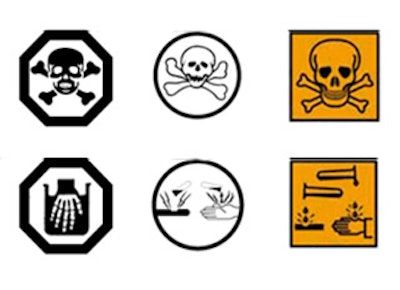
As the world continues to get smaller, and millions of pounds of chemical products are shipped between countries daily, a Global Harmonized System (GHS) is being implemented to aid in the communication of hazards and risks. The UN Conference on the Environment and Development (UNCED) met in 1992 and decided that global standards for chemical classification and labeling were needed. Every country had different requirements, causing confusion and increasing risk of serious accidents.
In 2005, the first revised edition of GHS was published, and has since been updated every two years. GHS established a standard system for classifying and labeling chemicals with the intent to have it fully implemented by 2008. It also impacts the content and organization of Material Safety Data Sheets (MSDS), which will be called Safety Data Sheets (SDS) moving forward.
Of course, getting every country in the world to agree on something is easier said than done. While the pictograms and signal words identifying particular hazards on labels are largely accepted, specific chemical classifications and the timing of GHS implementation varies widely from country-to-country. Europe is leading the charge, with adoption of GHS well underway. Here we'll examine how GHS impacts the North American region of US, Mexico, and Canada.
GHS Hazard Pictograms
The most noticeable and potentially alarming change for GHS is the pictograms, standardized symbols that represent the hazards of a chemical. Europe has long used standard pictograms, and the GHS pictograms are largely based on those designs. Canada has used two different sets of pictograms, one for workplace products governed by Workplace Hazardous Materials Information System (WHMIS), and one for consumer products from Consumer Chemicals and Containers Regulations (CCCR). The US has used different sets of pictograms depending upon regulatory agency jurisdiction, one for workplace products governed by Occupational Safety and Health Organization (OSHA), one for environmentally regulated products enforced by the Environmental Protection Agency (EPA), and one for consumer products by Consumer Product Safety Commission (CPSC). The CPSC has jurisdiction over certain chemical labeling under the Federal Hazardous Substance Act (FHSA). For the US, OSHA has not required standard symbols for workplace product packaging in the past. That’s not to be confused with Department of Transportation (DOT) required labeling, which requires standard pictograms. DOT pictograms are commonly found on trucks and shipping containers. The DOT has already adopted some elements of GHS. This also shouldn’t be confused with National Fire Protection Association (NFPA) and Hazardous Materials Identification System (HMIS) markings that are commonly found on US packaging, but have never been a requirement.
The following are GHS pictograms and how they compare to previous requirements. Not every symbol will be required for every country. For example, the US will not require the symbol for environmental toxicity, because it is not within OSHA’s jurisdiction; it falls under the EPA’s jurisdiction.

US: How Does This Affect Me?
The old requirements, as set by OSHA’s Hazard Communication Standard, are acceptable through the transition, but chemical manufacturers can change to the new GHS standards at any time. This opens the possibility of confusion and alarm in the workplace as new symbols pop-up in seemingly arbitrary ways during the transition. To eliminate confusion and ensure understanding among employees, OSHA required that all employees be trained on the new label elements and SDS format by December 1, 2013. By June 1, 2015, manufacturers will need to be shipping products with GHS labeling, and by December 1, 2015, distributors need to have their old inventory flushed out and be shipping only GHS labeled product. By June 1, 2016, users of these products need to have their inventories converted to GHS labeled products. At that point, the transition is over, and the US will have fully implemented the GHS standard.
See the transition summary below, provided by OSHA:

Mexico: First North America Country to Adopt GHS
While Mexico was the first North American country to adopt GHS, implementation of the GHS standard has been voluntary in Mexico. With the US implementation of GHS, it is an appropriate time to align Mexican and US workplace product labels.
Canada: Wait and See
Health Canada, Canada’s government body responsible for the work place labelling requirements, has not finalized how the current WHMIS related requirements will change or the timing of their transition. Draft regulations have been proposed, but a final document is not expected until 2014. In the meantime, the standard WHMIS markings in the hashed border are still required. It is expected that this will be replaced by GHS standard markings and a target “in force” date has been proposed for June 2015. For products being shipped to both US and Canada, which is commonly done, both GHS (US and Mexico) and WHMIS (Canada) markings are allowed. Canada will not accept a GHS only label while WHMIS is in effect.
Works Cited
Canadian Centre for Occupational Health and Safety. WHMIS – Labelling Requirements. By Canadian Centre for Occupational Health and Safety. Retrieved November 14, 2013: http://www.ccohs.ca/oshanswers/legisl/msds_lab.html
Globally Harmonized System (GHS). By Canadian Centre for Occupational Health and Safety. Retrieved November 20, 2013: http://www.ccohs.ca/oshanswers/chemicals/ghs.html
United Nations Economic Commission for Europe. Globally Harmonized System of Classification and Labelling of Chemicals (GHS): Historical background and implementation Status. By United Nations Economic Commission for Europe (UNECE). Retrieved November 20, 2013: http://www.unece.org/fileadmin/DAM/trans/danger/publi/ghs/GHS_presentations/English/ghs_intro_e.pdf
United States Department of Labor. OSHA Fact Sheet. Retrieved November 14, 2013: https://www.osha.gov/dsg/hazcom/HCSFactsheet.html
United States Department of Labor. Hazard Communication Pictograms. Retrieved November 14, 2013: https://www.osha.gov/dsg/hazcom/pictograms/
WHMIS and Hazardous Materials. By Western Convenience Stores Association. Retrieved November 19, 2013: http://www.retailsafety.ca/training/whmis-hazardous-materials
NOTE: This article is intended as an overview of the new labeling standards. It is not intended for any kind of certification or compliance training.























